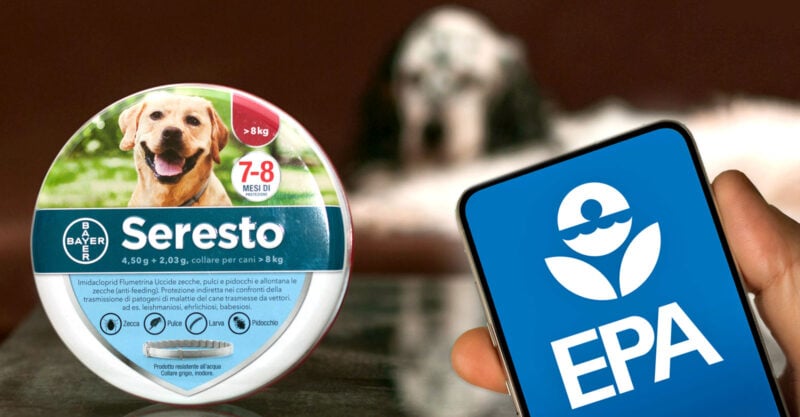Miss a day, miss a lot. Subscribe to The Defender's Top News of the Day. It's free.
By Johnathan Hettinger
The U.S. Environmental Protection Agency (EPA) has not properly reviewed the safety of a popular flea and tick collar that has been linked to more than 3,000 pet deaths, according to the agency’s top watchdog.
The EPA’s Office of Inspector General (OIG), an independent office in the agency tasked with holding the agency accountable, published a report on Feb. 29 calling on the EPA to make a proper, science-based decision on the Seresto product and improve its processes for making safety determinations for pet products.
The report found that the agency has not conducted or published animal risk assessments as it promised to do, and continues to rely on an inadequate 1998 companion animal safety study.
Seresto pet collars work by releasing two active ingredients, the pesticides flumethrin and imidacloprid. The OIG found that the EPA has failed to properly review those active ingredients, including in a new analysis last year.
Pet deaths
At a congressional hearing in June 2022, pet owner Faye Hemsley of Pennsylvania reported that her dog, Tigger, began to suffer from neurological issues, including his head drooping and a loss of energy, before dying five days after she first put the Seresto collar on him.
Thomas Maiorino of New Jersey also testified at the hearing that his family’s dog, Rooney, suffered neurological issues and eventually a seizure, after wearing Seresto. They eventually decided to put the dog down.
Many other pet owners reported neurological issues in their animals, including seizures as well as pet deaths.
The collars have been the subject of more than 105,354 incident reports, including 3,000 pet deaths, more than any other EPA-regulated product in history, according to the EPA’s incident database.
From 2012 through 2022, the EPA received more than 100,000 incident reports related to the collars, including more than 2,500 pet death reports and nearly 900 reports of human pesticide incidents related to the Seresto pet collars.
“The EPA’s response to reported pesticide incidents involving Seresto pet collars has not provided assurance that the collars can still be used without posing unreasonable adverse effects to the environment, including to pets,” the OIG report states.
The collar has been under sharp scrutiny in recent years after USA Today and Investigate Midwest published an investigation spotlighting the high number of incident reports about Seresto.
The U.S. House of Representatives Committee on Oversight and Government Reform, which is now the Committee on Oversight and Accountability, Subcommittee on Economic and Consumer Policy, launched an investigation and subsequently determined that the EPA knew for years that Seresto was linked to a high number of pet deaths but took no action and recommending that the EPA take it off the market.

The OIG report recommends that the EPA issue a new decision on the chemicals, but the agency disagrees.
In a response to the OIG, Michal Freedhoff, the EPA’s assistant administrator for the Office of Chemical Safety and Pollution Prevention, wrote that its 2023 investigation satisfied requirements under the Federal Insecticide, Fungicide and Rodenticide Act, which is the law regulating pesticides.
Freedhoff said there was a lack of evidence to tie the pesticides in the collars to the pet deaths.
“In many of the death-related incidents, critical details of the incident were often missing, preventing the Agency from determining the cause of the death,” Freedhoff’s response states.
Freedhoff’s response continues:
“The only reported deaths that were found to be ‘probably’ or ‘definitely’ related to Seresto product use were associated with mechanical strangulation or trauma caused by the collar, often associated with a failure of the release mechanism.
“In addition, the rate of deaths reported for Seresto was similar to that for other pet products reviewed.”
But the OIG found that the EPA’s July 2023 investigation was fundamentally flawed and said the agency needs to improve assessments of adverse effects on pet health and update inadequate animal safety guidelines to align with international standards.
Lacking regulatory rigor
Overall, the OIG found that there have been at least six previous reports over the past 16 years that have found the EPA’s pesticide incident reporting system to be lacking.
The report said the incident data system is unreliable because of underreporting and suspect data quality, and the agency does not have a standard system or methodology for evaluating incidents involving pets.
The report also found the EPA Office of Pesticide Programs has no pet health office or division, no advocate for pet safety and a lack of veterinary expertise.
Last year, the EPA proposed transferring all regulation of pet products to the U.S. Food and Drug Administration.
The OIG also recommended the EPA implement standard operating procedures for how to conduct domestic risk assessments and measurable standards to determine when a product poses unreasonable adverse effects.
The OIG also recommended EPA implement better data requirements both pre-approval and for incident reporting.
“EPA product registration signals to the public that this product has undergone rigorous scrutiny and is deemed safe for public use,” EPA Inspector General Sean W. O’Donnell said in a press release.
“Registration reviews must be conducted at the highest standard to safeguard public trust and protect human health, pet health, and the environment.”
Originally published by The New Lede.
Johnathan Hettinger is an independent journalist focusing on the environment.









